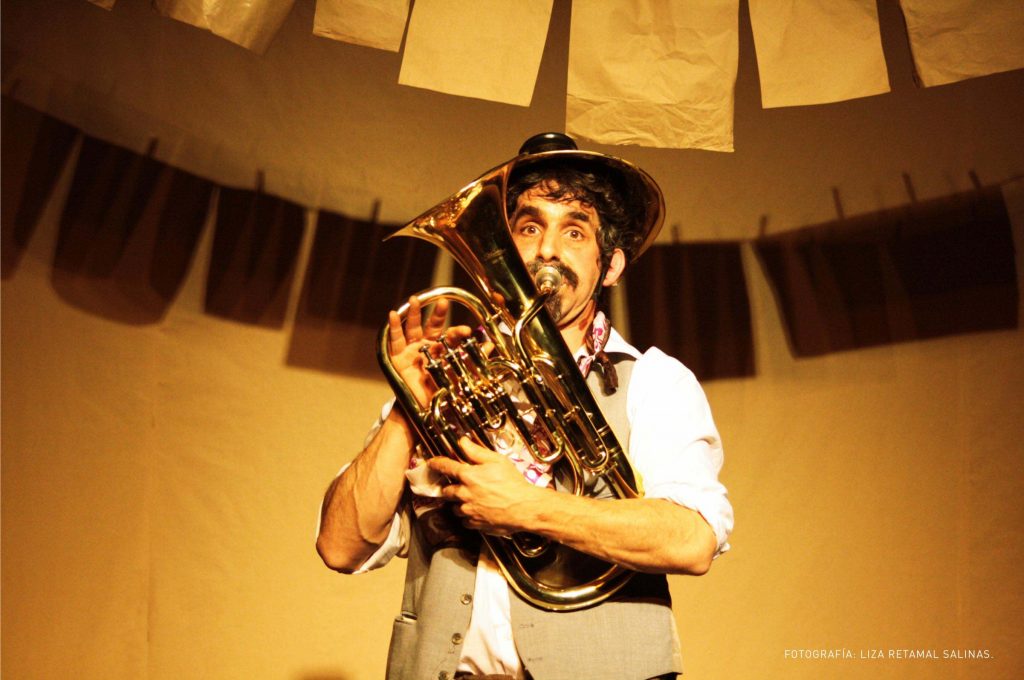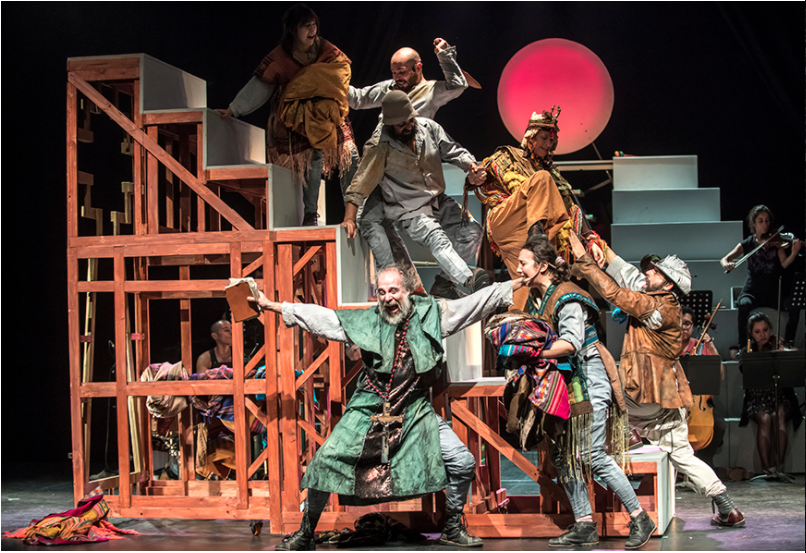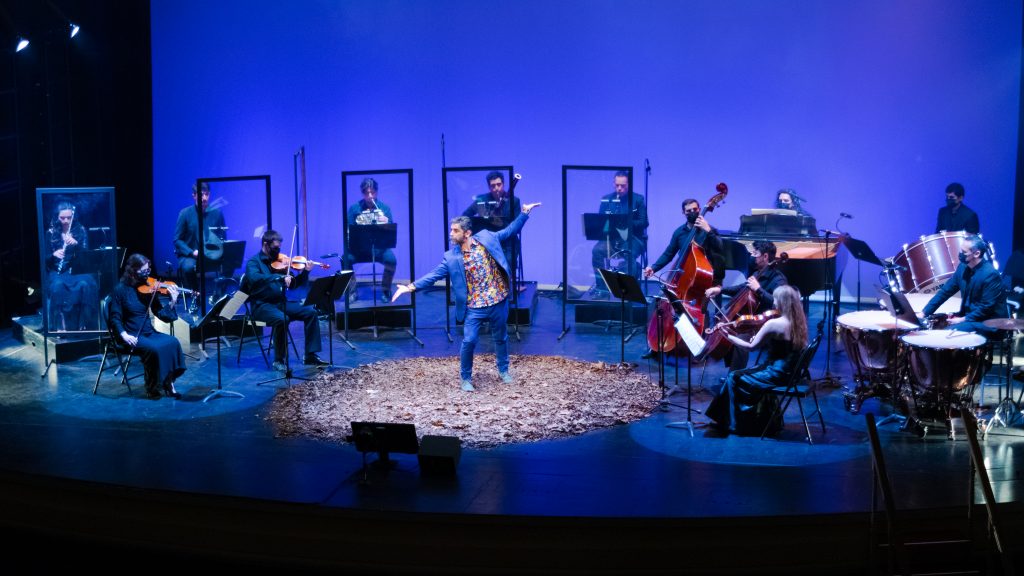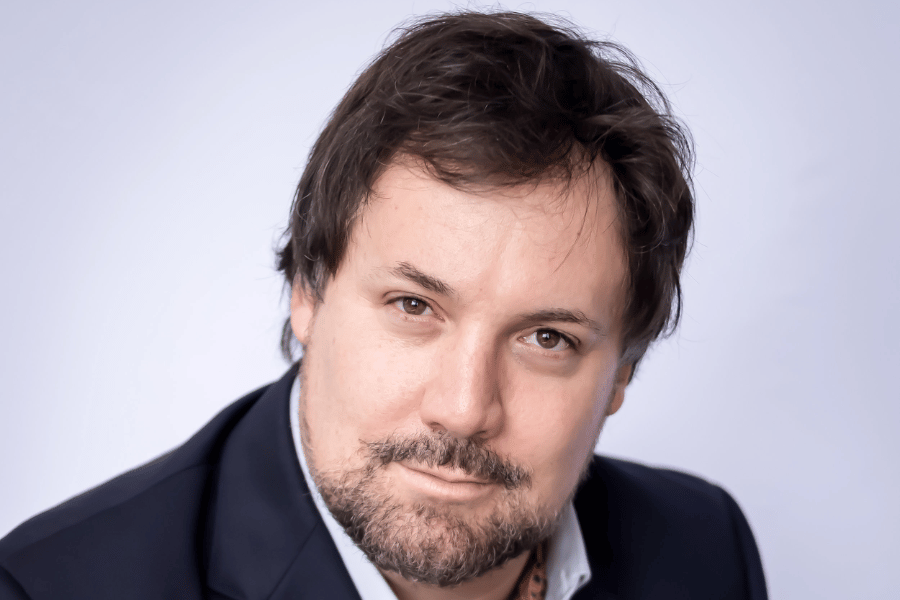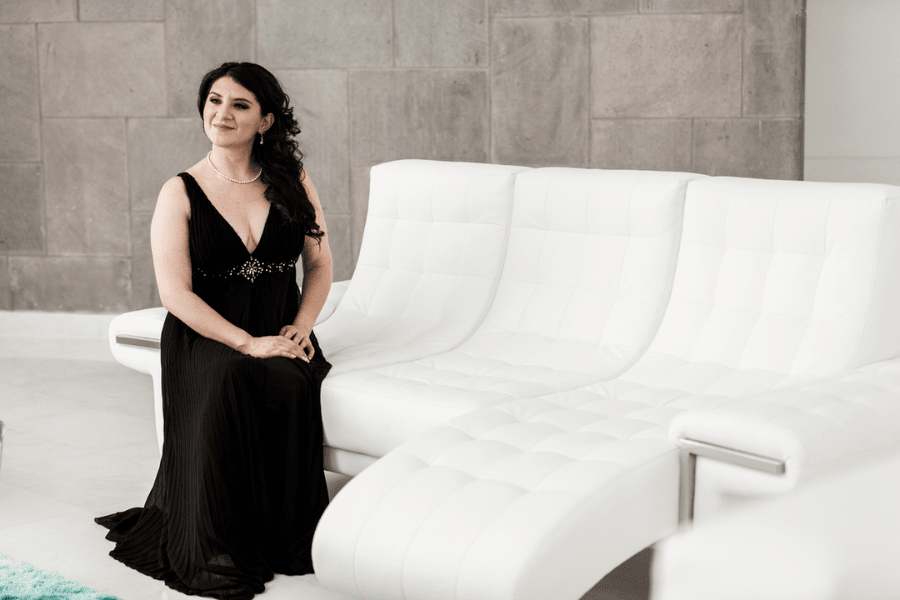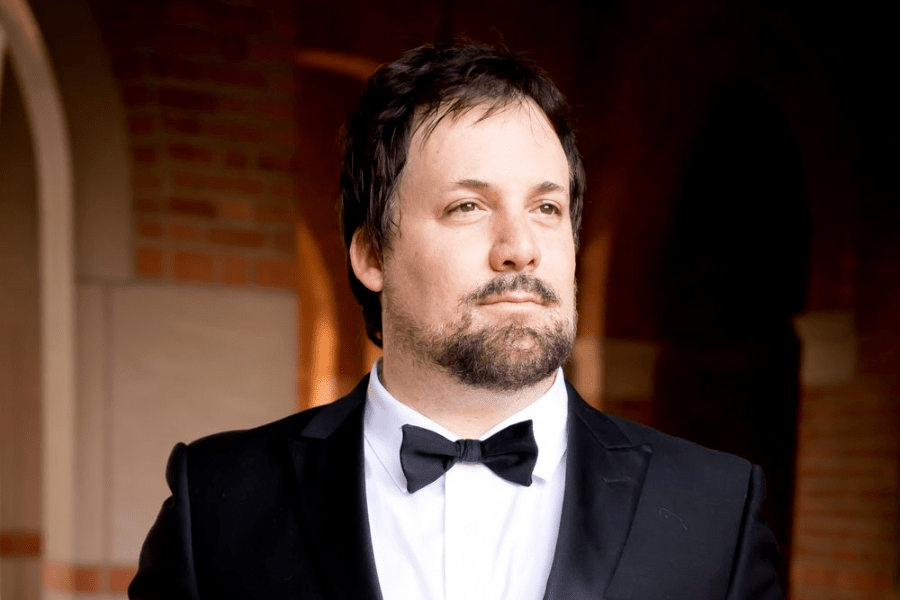Francisco Sánchez, director de escena: “Todo lo que somos culturalmente aflora en el escenario”
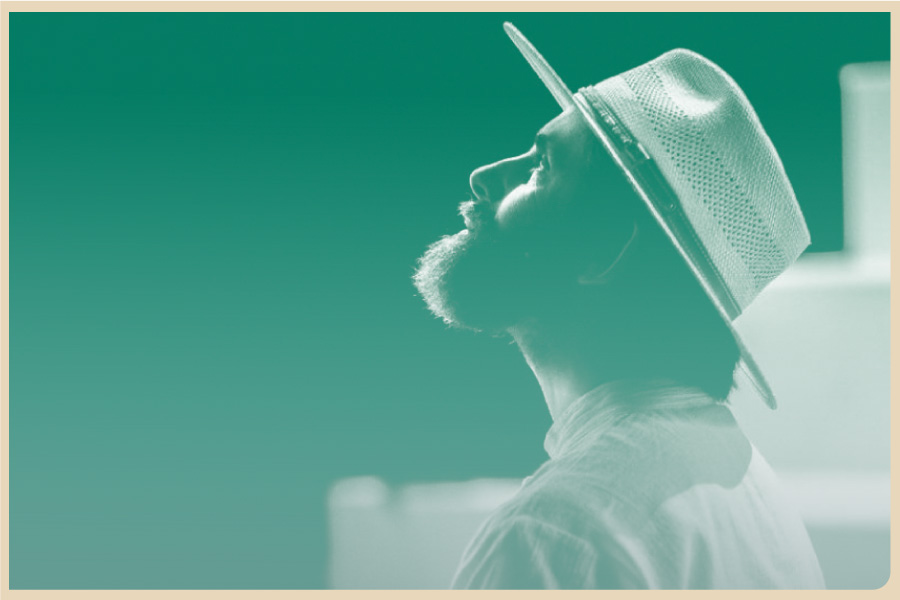
Actor, compositor, músico, dramaturgo y director de escena, el perfil artístico de Francisco Sánchez, miembro de la plataforma Escena Digital, se enmarca en el de la “obra de arte total”. Hace 21 años fundó junto a su esposa, Carolina González, la compañía teatral independiente Tryo Teatro Banda, la cual se especializa en el teatro musical juglaresco y rescate de los mitos, las leyendas e historias de Latinoamérica e Iberoamérica. En sus obras, emerge una exploración hacia lo más visceral de las culturas y las formas de expresión humana, siempre acompañadas por la música y el juego constante arriba de los escenarios. Los sonidos e instrumentos, la composición musical, las emociones y la actuación, todos los elementos de las artes – y también la investigación y docencia – confluyen en el trabajo de este artista chileno.
por Álvaro Molina
Fue a través de la experiencia en la escuela que Francisco Sánchez, director de escena y miembro de la plataforma Escena Digital, se acercó a las artes y a lo que pronto se convertiría en su vocación profesional. “Desde niño que concebí las artes como una unidad. Siempre he sentido que hay un ámbito artístico del ser humano que tiene ramificaciones y variaciones”, explica.
Francisco hizo su debut artístico en la reconocida obra de teatro circense “Las siete vidas del Tony Caluga”, que llevó a la inmortalidad al conocido y querido payaso Tony Caluga, personaje creado por el artista chileno Abraham Lillo Machuca. El Tony Caluga tuvo su momento de mayor apogeo durante la década de los sesenta en Chile y es considerado como una figura emblemática de la cultura popular chilena. “Fue todo un fenómeno cultural. Yo tenía apenas 22 años y me dio la sensación de estar en algo extraordinario”, señala Sánchez.
Pronto, el camino del juglar y el teatro musical llevó a Sánchez a estudiar música y actuación en la Escuela de Teatro e Instituto de Música de la Pontificia Universidad Católica de Chile. Con la claridad de conjugar el teatro y la música, el 2000 Sánchez fundó junto a su esposa, Carolina González, la compañía teatral independiente bajo el nombre de Tryo Teatro Banda, una troupe escénica que trabaja, entre otros temas, el rescate de la identidad histórica en el continente iberoamericano.
En esta entrevista para Ópera Latinoamérica, Francisco Sánchez aborda su relación con las artes, el camino que recorrió para llegar a enfocarse en el juglar y la importancia del desarrollo y formación de públicos en Latinoamérica.
- ¿Cuál es tu primer recuerdo en un teatro? ¿Puedes describir el ambiente o lo que sentiste en ese minuto?
Mi primer recuerdo en un teatro es en mi colegio, que se llamaba Notre Dame. Había un grupo teatral muy bueno e importante que hacía obras de creación colectiva, es decir, los alumnos hacíamos las obras y el texto. En ese entonces, el profesor Ignacio Canales fue una figura muy relevante en todo ese proceso de formación.
Debo haber estado en 4° básico (primaria), por el año 1980, cuando fui a ver a los actores de la enseñanza media (secundaria) que representaban la obra de teatro anual. Era un evento muy esperado en todo el colegio, ya que era la obra que había preparado el equipo de expresión durante casi todo el año. Venían alumnos y personas de otros colegios y era mucha la expectación.
Lo que me impresionó fue ver a uno de los actores bajarse del escenario, en medio de las luces y los focos, y sacarse el maquillaje con un pañuelo. Encontré que eso era lo más “cool” que se podía hacer, porque había mucha gente en el público y era un acto como si fueran actores de cine.
- ¿Cómo fue tu debut en la escena teatral? ¿Con qué obra fue? ¿Cómo lo recuerdas?
Tuve la fortuna de participar en “Las siete vidas del Tony Caluga”, una obra de Andrés del Bosque, en la que estaba a cargo de la música como payaso. La obra tuvo un éxito inaudito y ganó muchos premios. Estábamos en una carpa de circo cerca de Plaza Dignidad (Plaza Italia, Santiago de Chile) y era todo un fenómeno cultural. Tuvo varias funciones y mucho público. Yo tenía apenas 22 años y me dio la sensación de estar en algo extraordinario. Fue mucha la emoción.
Desde mis primeras experiencias teatrales en el colegio yo actuaba, tocaba y componía siempre como una misma expresión, pero ahora eso se trasladó al ambiente de una carpa de circo, en una obra famosa, exitosa y muy emocionante.
- ¿Cuál ha sido el mayor desafío en tu desarrollo personal profesional? ¿Cómo lo abordaste?
Constantemente hay desafíos para sostener una compañía de teatro independiente en el tiempo y cada obra que uno crea es un gran reto. Sin embargo, creo que el mayor desafío personal fue la musicalización y orquestación de cuatro cuentos clásicos versionados por Gabriela Mistral para la obra Gabriela Mistral Canta Cuentos: “La bella durmiente del bosque”, “Caperucita roja”, “Blancanieve en la casa de los enanos” y “La cenicienta”. Esta producción la realizamos en conjunto con la Fundación de Orquestas Juveniles e Infantiles de Chile (FOJI) y su director, Juan Pablo Aguayo. Con él logré pulir mucho la calidad del trabajo musical.
Siempre he querido juntar el mundo de la música clásica con el teatro. Tomar un texto poético -yo generalmente no trabajo con textos, sino que con temas que voy elaborando- y musicalizarlo, orquestarlo y cantarlo fue un tremendo desafío como compositor y director. En las obras, contamos con una orquesta clásica y con las actrices Annie Murath y Daniela Ropert, quienes cantaron “Blancanieve en la casa de los enanos” y “La cenicienta”, respectivamente. Por mi lado, yo canté “Caperucita roja”.
En el fondo, fue contar un cuento, actuar, musicalizar y poner en escena, por lo que estaban todas las disciplinas juntas. Por lo general, las obras de Tryo Teatro Banda son muy exigentes, pero en el caso de estos cuentos clásicos el punto de partida fue la composición musical. Es una experiencia reciente que siento como un logro y me tiene muy contento.
¿Cómo lo abordé? Primero, estudié el texto y luego tomé la guitarra y compuse una gran canción, como si fuera un aria. Por ejemplo, “La bella durmiente en el bosque” dura 14 minutos, la narración es cantada, pero cuando los personajes tienen parlamentos en el texto, eso se hizo hablado. Por lo tanto, es una gran canción de 14 minutos a la que siento que le di una teatralidad especial para luego orquestarla. Así, la orquesta recoge las experiencias musicales de la música en vivo de mi compañía.
La identidad a través del trabajo colectivo
- ¿Cómo llegaste al tema del teatro musical y el juglar?
Desde niño que concebí las artes como una unidad. Siempre he sentido que hay un ámbito artístico del ser humano que tiene ramificaciones y variaciones. Se puede trabajar con materiales distintos, pero la esencia es la misma.
Cuando era pequeño me gustaba tanto la música como el teatro, entonces me parecía natural tocar instrumentos en una obra de teatro. Después estudié un poco de actuación y música y comencé a darme cuenta de que tener esa especialidad -actuar y tocar música- era algo curioso, que siempre tenía un espacio, entendiendo que la música está al servicio del teatro y se complementa y dialoga con él. Esa claridad fue muy importante y cuando empecé a trabajar profesionalmente, esa habilidad me entregaba muchas posibilidades. De hecho, en 2016, fui a estudiar a Florencia, Italia, dirección de ópera, dramaturgia musical y libreto de ópera y tomé clases con la regista Vivian Hewitz.
Sobre el juglar, trabajé con Andrés del Bosque en el espectáculo “Las siete vidas del Tony Caluga” en 1994. Andrés es un actor, director, dramaturgo y profesor que hace mucha investigación. Él estaba investigando a los payasos y sus técnicas de actuación. Ahí metí como músico a la banda de payasos a esa obra de teatro-circo.
Con Andrés trabajamos sobre el canto a lo humano y lo divino, una tradición de música y poesía chilena que nos conecta con el guitarrón chileno y la antigua poesía de los romances españoles. Cuando encuentras al trovador, también encuentras al juglar, porque es el artista ambulante que canta y cuenta historias con su instrumento. El juglar tiene ese ideal de artista que canta y toca y prácticamente puede hacer lo que quiera (malabarismo, acrobacias, sombras chinescas, equilibrismo, etcétera). Es un actor que usa muchas herramientas para contar historias. Esa identificación para mí y mi compañía es fructífera e infinita.
- En el caso de Tryo Teatro Banda destaca el trabajo de rescate de la identidad. ¿Crees que el origen cultural de una persona influye en las formas de hacer arte? ¿Ha tenido alguna influencia en tu caso? ¿Cuál?
La compañía toca el tema de la identidad a partir de la historia. El teatro cuenta historias, entonces elegimos tomar las historias de nuestro pueblo chileno, latinoamericano e iberoamericano. Son historias que también pueden encontrarse con pueblos originarios, lenguas, instrumentos musicales, sonidos y tradiciones.
Es un interés que tiene que ver también con sanación. Al trabajar con la identidad de la historia de Chile, por ejemplo, afloran las históricas injusticias, el racismo y clasismo. El teatro denuncia y desnuda todo. Es un intento de trabajar con las identidades desde un sentido de justicia.
Naturalmente, el aspecto cultural de una persona influye en el tipo de arte que hace, es algo absoluto. En el caso de los chilenos, es explorar cómo hablamos, cómo nos comunicamos, si nos atrevemos a debatir o no, cuán valientes somos al momento de discutir o mantener una idea. Todo lo que somos culturalmente aflora en el escenario. El teatro y la música permiten canalizar esa cultura hacia algo más universal, donde estamos todos los humanos conectados y compartimos una esencia. Las culturas son características, como el “condimento”, pero la materia es la misma.
Personalmente, una influencia cultural potente que tuve fue el carnaval de Oruro en Bolivia. Me cambió la mirada. Fui nueve veces al carnaval, cuatro como músico y las otras como espectador. Es la capital cultural de la Sudamérica andina y fue una influencia grandísima, tan grande que el último gran espectáculo de Tryo Teatro Banda, “Tragicomedia del Ande” (en la que trabajé mucho con el compositor Sebastián Errázuriz, quien hizo la orquestación), nació como idea luego de la primera vez que fui al carnaval de Oruro. Allí los bolivianos cantan y bailan para contar su historia. Era casi como estar frente a una ópera, con sus propios personajes, vestuarios y escenografías.
Pero también está Italia, cuando viajé a estudiar. Aproveché de recorrer y visitar casas de ópera en Florencia, Pisa, Génova, Roma. Viajaba por tren leyendo la historia de las óperas y luego ir a verlas en estas ciudades italianas. Fue una experiencia inolvidable.
- ¿Tienes algún proceso creativo a la hora de concebir una dirección escénica? ¿Puedes describirlo?
Hace un tiempo vengo trabajando con la premisa de encontrar un hecho o tema histórico y desarrollarlo a partir de la improvisación, o sea, escribir el texto en los ensayos y la música. Mucho aflora en la improvisación y creatividad del momento. Lo que sí tengo claro es ese método que he desarrollado junto a Sebastián Vila, un gran actor y director de teatro que conozco desde que tenía 5 años.
A veces voy incorporando cosas nuevas, a veces hago repeticiones, pero en el fondo confío mucho en el trabajo creativo en equipo. Por ejemplo, que todos lean del tema que estamos trabajando. Todos nos informamos, aprendemos y profundizamos en los contenidos de un tema para luego desarrollarlo escénicamente. Eso hace que cada integrante del elenco esté más interesado en algún aspecto del tema a tratar que otro y logra que cada uno sienta que ha creado la obra y no solo es un intérprete. Le pido a los actores que canten canciones, toquen instrumentos, a veces que se dediquen a un instrumento en particular o les pido que traigan cosas suyas, propias.
En general, es trabajo colectivo donde el director tiene la última palabra, pero también es un direccionador de la creatividad de los artistas y los actores. Por ejemplo, en conjunto decimos: “Vamos a contar la historia de este punto a este otro punto, pasaremos por aquí y por allá, estos son los personajes y estos son los conflictos”. Luego nos tiramos a jugar. ¿Cómo resolvemos el cuerpo como un instrumento de expresión física? Luego la actuación, que son las actitudes humanas, ¿cómo imitas a otras personas? Actúas o imitas en base a lo que te has observado a ti mismo y a los demás, los conflictos humanos, los fracasos, las pretensiones.
Luego, a nivel de texto tratamos de no sobreabundar. La palabra corona la acción o dice lo que el cuerpo no puede decir. Aunque es cierto que hay una poesía o musicalidad que es linda de escuchar.
La música está presente todo el tiempo. La última obra que hicimos, “Magalhaes”, está basada en la expedición de Hernando de Magallanes. Esta obra es muy particular porque se hizo antes y durante la pandemia, con ensayos telemáticos durante el encierro. Es una coproducción entre Matucana 100, el Teatro Municipal de Ovalle y el Teatro Regional del Maule y Tryo Teatro Banda.
Para esta obra, le pedí a los actores que siempre estuvieran con un instrumento en la mano. Entre la gente que participó están Alfredo Becerra, Javier Bolívar, Diego Chamorro, Martín Feuerhake y Daniela Rivera. En la primera media hora de espectáculo, ellos no sueltan los instrumentos, que son los barcos, las orillas de playa, objetos e instrumentos musicales. Fueron los mismos actores quienes compusieron e interpretaron la música de la obra desde los ensayos, ya que gran parte del equipo son compositores y músicos.
A los actores y juglares les pido que tengan presente cómo su instrumento les sirve para tocar, acompañarse y crear imágenes bellas.
La unión con los públicos en las artes
- ¿Qué rol pueden o deben tener las artes y las culturas en el contexto actual?
Las artes y la cultura siempre han tenido el mismo rol, independiente del contexto. Lo que pasa es que el contexto hace ver la necesidad de que la cultura sea fomentada, protegida, ayudada y que se estimulen las audiencias. En el fondo, la gente cuando accede al arte y la cultura se pone más inteligente. Todos, incluso los que estamos haciéndola. Los artistas también somos públicos, somos parte del mismo fenómeno.
El arte y la cultura junta a la gente en un espacio. Te puedes sentar al lado de una persona desconocida y reírte, llorar con ella. Como el arte sana y junta a la gente, su rol es el mismo de siempre, solo que en este contexto se hace más necesario.
No creo que sea deber de las artes transmitir conceptos ideológicos (aunque sí puede hacerlo). Nunca se le debe decir al espectador lo que debe pensar o decidir. Para mí el rol de las artes y la cultura es trabajar con ideas, conceptos, creatividad e imaginación dejándole la libertad al espectador de pensar y sentir.
- Pensando en Latinoamérica, ¿cuál es tu diagnóstico con respecto a la difusión de las artes y las culturas? ¿Hay tareas pendientes? ¿Qué diálogos se deberían establecer?
La tarea que está pendiente es la formación de audiencias, que la gente entienda lo que es el teatro, que le guste ir y esté dispuesta a pagar una entrada así como va a un McDonald’s o paga una entrada al cine. Que la gente conozca el teatro y la música, que experimente el beneficio que le trae para su alma y que por lo tanto lo quiera. El énfasis debe estar puesto en que los artistas queramos llevar el teatro musical a todas partes y que haya posibilidades de hacerlo. Creo que eso es lo que hace falta en Latinoamérica. La circulación, la difusión, el acceso al teatro. Que no sea una cosa elitista con entradas caras, sino que haya una política tanto de los artistas como de las autoridades, que haya teatro en todas partes y todo el rato. Eso haría que florezca este arte en todos los rincones.
- Si tuvieras que elegir cinco obras, compositores, discos, artistas u óperas para vivir en una isla desierta, ¿cuáles serían?
Viviría con el quinteto para clarinete de Brahms, con la séptima sinfonía de Beethoven, con “El pájaro de fuego” de Stravinsky, alguna obra de Mozart que podría ser el concierto para clarinete, la Pavana para la infanta difunta de Ravel y con la Ofrenda musical de Bach.


